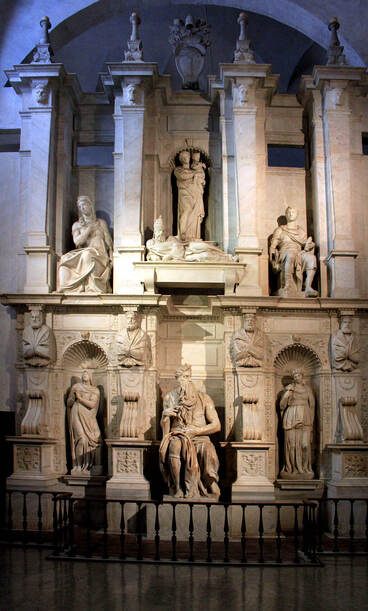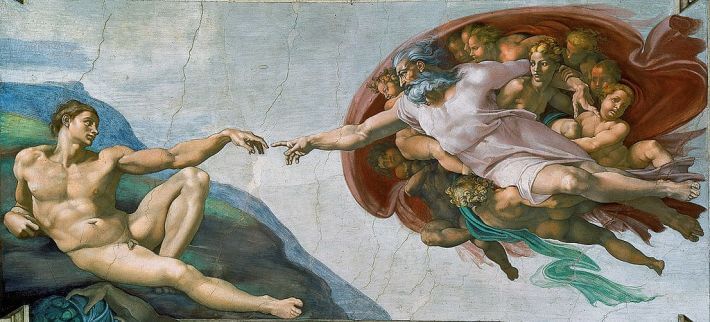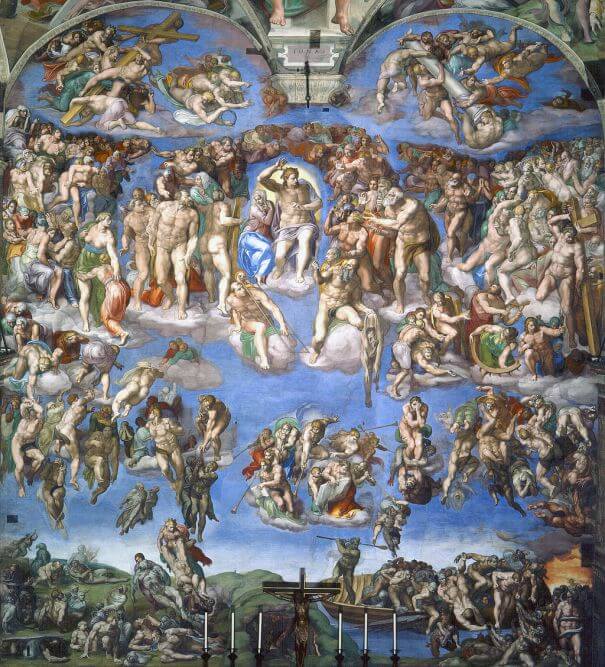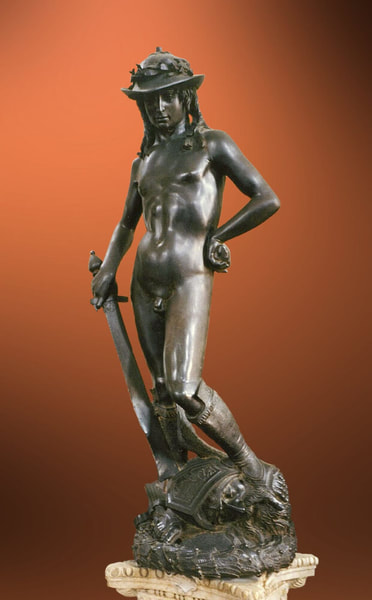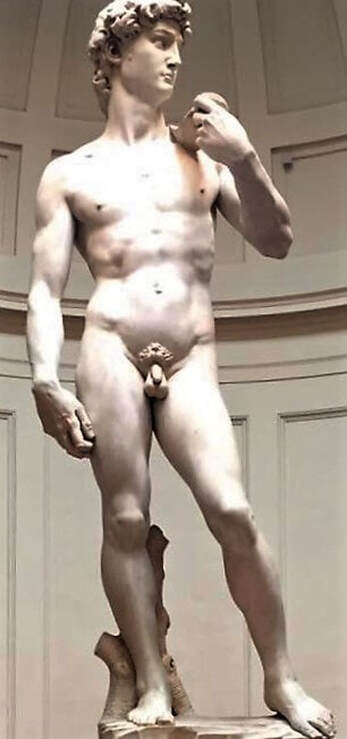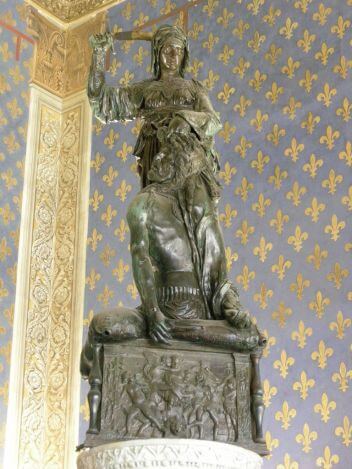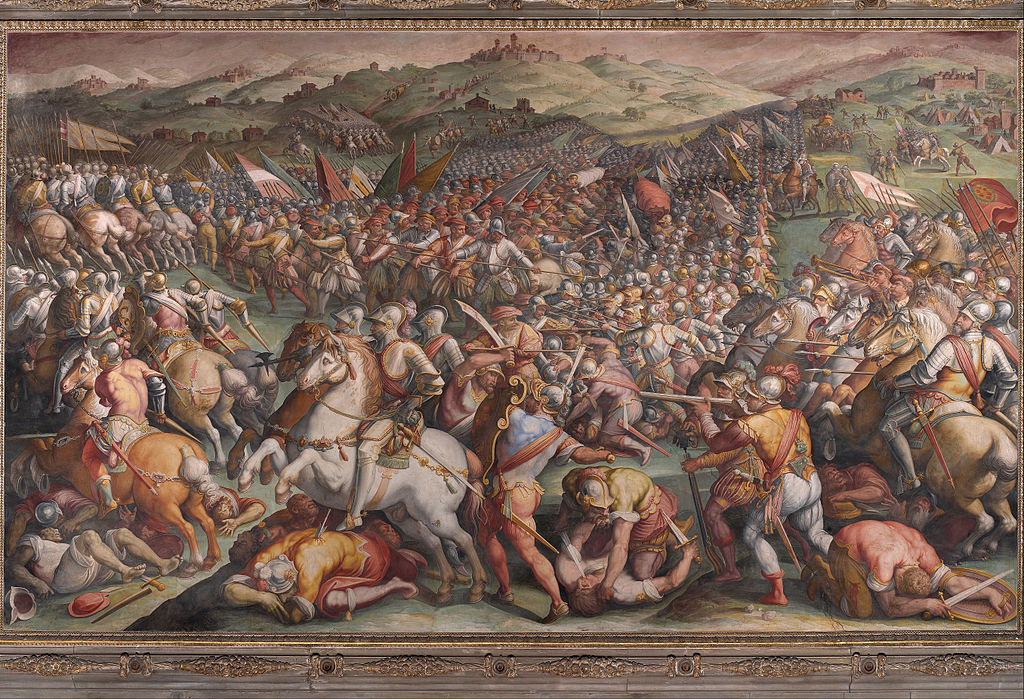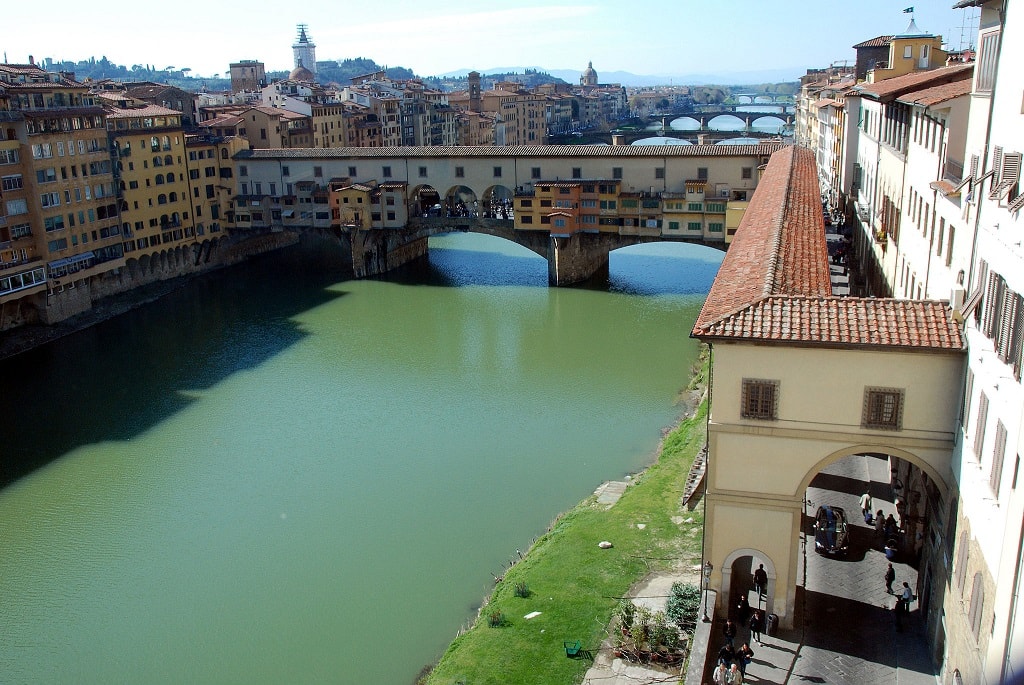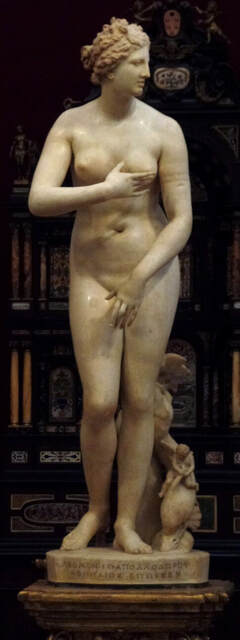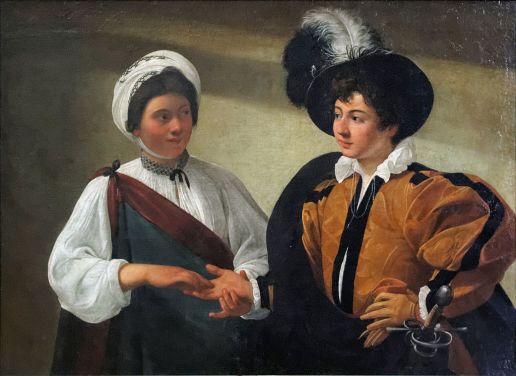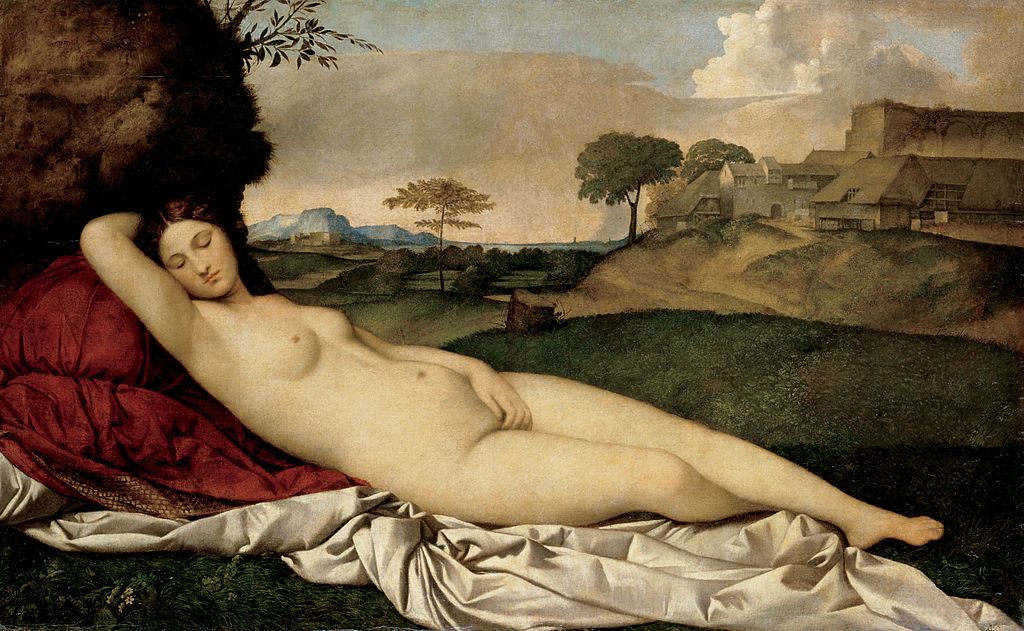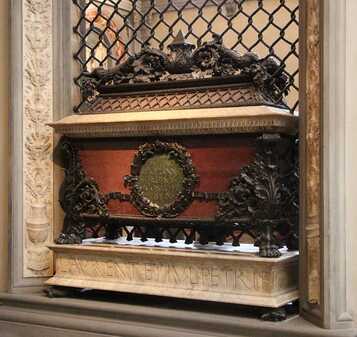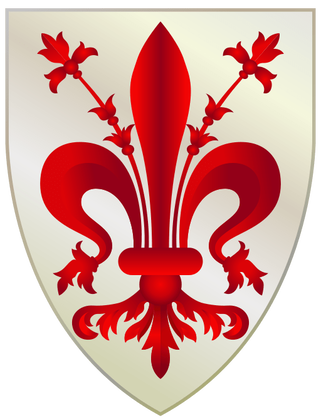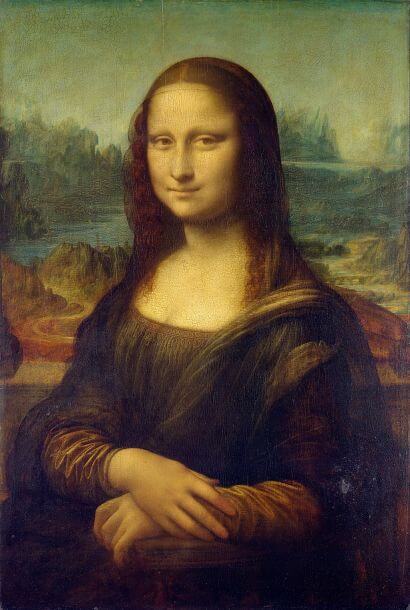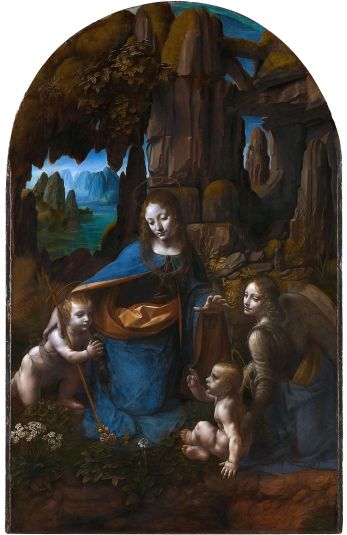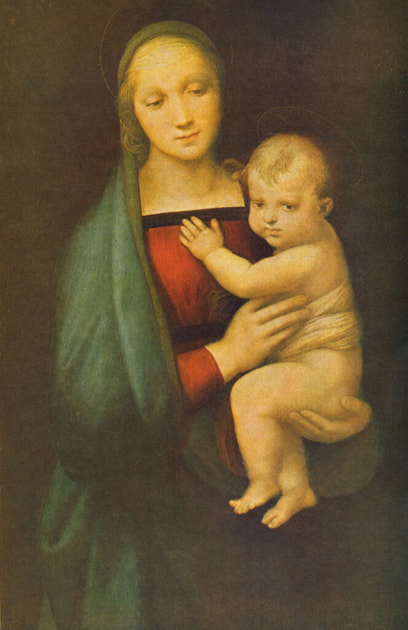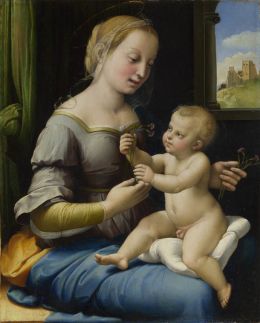|
Where? Hall of the Five Hundred in the Palazzo Vecchio
When? 1532-1534 Commissioned for? The tomb of Pope Julius II What do you see? Two male figures. A vigorous young man is standing with a crown of oak leaves and is holding a sling. The body is twisted in an extreme way, but Michelangelo makes it look like a comfortable position. The body of the young man is finished to perfection. In contrast, at the feet of the young man is an old and wrinkled conquered warrior. The knee of the young man seems to push hard onto the head of the old man. The sculpture is unfinished at the bottom, which allows you to admire the sculpting techniques of Michelangelo. More about Michelangelo’s sculpting techniques can be learned in this video. Backstory: Michelangelo made this sculpture of almost 9 feet tall (2.61 meters) for the tomb of Pope Julius II (1443-1513). He was the Pope from 1503 until his death in 1513. Pope Julius II was also known as the ‘Warrior Pope,’ as he was very active to make the papacy the most dominant military and political force in Italy. This is also the reason that a statue of a victorious young man seems fitting for his tomb after his death. It is also no coincidence that Michelangelo was asked to create this statue as Pope Julius II was the one that commissioned Michelangelo’s famous frescos at the ceiling of the Sistine Chapel. Symbolism: The oak leaves in the crown of the standing man refer to the emblem of the house of Della Rovere (which means ‘of the oak tree’), a noble Italian family that produced two popes. Several interpretations have been given to the statue, but one of the popular ones is that this statue is an allegory of the victorious overlooking the defeated. Why the tomb of Pope Julius II? In 1505, Pope Julius II commissioned Michelangelo to create the Pope’s tomb for after his death. The original idea was to create a freestanding tomb seven meters wide, eleven meters deep, and eight meters high, with about 40 statues. However, due to a lack of funding and people convincing the pope that it was bad luck to have his tomb built while he was still alive, the project got delayed. After the death of the Pope, the project got gradually less ambitious, and the final tomb includes substantially fewer statues and is not freestanding anymore. The tomb can be found in the San Pietro in Vincoli Church in Rome.
Who is Michelangelo? Michelangelo di Lodovico Buonarroti Simoni (1475-1564) was an architect, engineer, painter, poet, and sculptor. He is considered to be one of the greatest artists ever and was considered the best artist of his time. He is probably most well-known for his sculptures (think about the David and the Pietà) and his frescos in the Sistine Chapel such as the Creation of Adam and The Last Judgment.
Fun fact: The standing young man in this statue is believed to be Tomasso dei Cavaleiri. Michelangelo was 57 when he met Cavaleiri, who was 23 at that time, and fell in love with him. Michelangelo dedicated 30 poems to Cavaleiri in which he expressed his love for him and also used him as inspiration for some of his other works. They remained lifelong friends, even though, Cavaleiri married in 1538 and got two children with someone else. The adoration of the male body was not completely uncommon during the Renaissance. Leonardo da Vinci also showed this appreciation in his work.
0 Comments
Patrick A. Rodgers, CC BY-SA 2.0
Where? Room 7 on the first floor of the Bargello Museum
When? Uncertain, but sometime between 1425 and 1455 Commissioned by? Cosimo de’ Medici
Backstory: In 1408-1409, Donatello also created a sculpture of David. This marble sculpture, however, is clothed and can also be found in the Bargello. According to Vasari, the pedestal for the bronze statue of David is probably created by Desiderio da Settignano. This statue is the oldest surviving bronze since antiquity. Bronze was perceived to be the most precious metal after gold, and therefore it was considered to be a special statue.
Inscription: The base of this statue carried a Latin inscription, which can be translated as: “The victor is whoever defends the fatherland. God crushes the wrath of an enormous foe. Behold - a boy overcame a great tyrant! Conquer, O citizens! Kingdoms fall through luxury, cities rise through virtues. Behold the neck of pride, severed by the hand of humility.” This inscription was intended to remind the Medici family of how to reign Florence.
Symbolism: This statue symbolized the victory of humility (represented by David) over tyranny (represented by Goliath). The Medici family displayed this statue in the courtyard of the Medici Palace to remind them and others of their humility and strength, but also to justify potential violence against people who were against their regime. The statue was placed footsteps away from the famous Judith and Holofernes statue by Donatello which can now be admired in the Palazzo Vecchio. The cupids on the helmet of Goliath are a symbol of non-religious passion and are a reference to the pagan people who are defeated by God. The wreath of laurel on David’s head is an indication of his victory over Goliath.
Who is Donatello? Donato di Niccolò di Betto Bardi (c. 1386-1466), better known as Donatello, was born in Florence. He was a sculptor that was ahead of his time. He was initially trained in a workshop of a goldsmith. Early in his career he worked together with and learned from Lorenzo Ghiberti and Filippo Brunelleschi. He has created statues and reliefs using materials such as bronze, stone, wax, and wood. Together with Leonardo da Vinci, Michelangelo, and Raphael, he is considered to be one of the four greatest artists of the Renaissance.
Fun fact: It is assumed that Donatello was homosexual and some people argue that he created this nude statue of David deliberately in a daring erotic posture. The left wing of the helmet that runs all the way up the right leg of David until the groin is interpreted as another sign that this is a homoerotic statue. Homosexuality, however, was forbidden during that time in Florence, but Donatello’s good friend Cosimo de’ Medici defended him from insults and the law. Cosimo was known to appreciate very talented artists and therefore he overlooked some of the bad behaviors that they may display. Interested in a copy for yourself? Poster, canvas, or statue (Amazon links).
Where? Hall of the Five Hundred in the Palazzo Vecchio
When? 1565 Commissioned by? Duke Cosimo I de’ Medici What do you see? The battle of Marciano is a bloody battle between the Republic of Siena and Florence, which was won by the Florentine. In the foreground, several explicit scenes are depicted of people getting killed in man-to-man battles. The rest of the fresco shows the battle between the large armies of Florence and Siena. Backstory: This fresco is also known as the Battle of Scannogallo (which was a creek near the village of Marciano della Chiana). The fresco marks the victory of the Florentine army over the army of Siena. The Florentine army worked together with the Spanish army, while the Republic of Siena got help from the French army. Both sides had a total of about 15 thousand soldiers that day. While on the Florentine side only 200 people got killed, the Siena side suffered losses of 4,000 with an additional 4,000 people captured. Why the Battle of Marciano? The battle of Scannagallo took place on August 2, 1554. It was a battle between the Florentine army under the command of Gian Giacomo Medici (following orders of Duke Cosimo I de’ Medici) and the Siena army under the command of Piero Strozzi. The goal of Duke Cosimo I de Medici was to get complete control of Tuscany, and for that, the Republic of Siena had to be conquered. This battle was a very important event in the decline of the Republic of Siena, and in 1559 they finally surrendered to Florence. Who is Vasari? Giorgio Vasari (1511-1574) was an architect, historian, painter, and writer. The paintings in the Hall of the Five Hundred are considered to be one of his best paintings. He was also the creator of the Hall of Geographical Maps which is also in the Palazzo Vecchio. Vasari was also a very successful architect and his work includes the construction of the Uffizi Museum and the Vasari Corridor in Florence. However, he is most famous nowadays for his book e Vite de’ più eccellenti pittori, scultori, e architettori da Cimabue insino a’ tempi nostril, translated as Lives of the Most Excellent Painters, Sculptors, and Architects, from Cimabue to Our Times, which documents the history of the Italian Renaissance (Amazon link to the book).
Dan Brown: This painting plays an important role in the book Inferno by Dan Brown (Amazon link to the book). On a green flag in the top middle of the fresco the words ‘cerca trova’ are written, which means ‘seek and ye shall find’. Without binoculars, it is almost impossible to see this.
The green flags belonged to the Siena army and they used to include different verses of Dante on them for inspiration. Duke Cosimo I wanted the sentence ‘cerca trova’ to be included in the painting as an ironic reference to the ‘defeat’ that the Siena army found. In Dan Brown’s book Inferno the words ‘cerca trova’ play an important role and lead the main character Robert Langdon to the death mask of Dante. What is a Fresco? A fresco is a painting that is executed using the fresco technique. This technique paints directly on wet lime plaster (a mix of sand, water, and lime that becomes solid when it dries). After the pigment is applied to the wet plaster and the plaster dries, the painting becomes an integral part of the wall. A mural is a more general word than a fresco as murals can also be created using different techniques. Fun fact: It has long been believed by many that below the fresco of Vasari a famous fresco of Leonardo da Vinci can be found. In 1505 Leonardo da Vinci completed a fresco called The Battle of Anghiari. This fresco is referred to as the ‘lost Leonardo’ and preparatory sketches from Leonardo for this fresco and copies by later artists, such as Peter Paul Rubens, serve as evidence for the existence of this fresco. There are three reasons to believe that the lost Leonardo may indeed still be hidden here.
Interested in a copy for yourself? Poster or Canvas
Where? Room 10-14 of the Uffizi Museum
When? Between 1482 and 1485 Commissioned by? Lorenzo the Magnificent (1449-1492), ruler of the Florentine Republic and one of the most important driving forces of the Renaissance.
Symbolism: Violets, the flowers of love, are blowing in the wind on the left. The shell represents feminism. The dress of Ores and the robe she is holding for Venus are decorated with various spring flowers related to the birth theme, including red and white daisies, blue cornflowers, and yellow primroses.
Who is Venus? Venus is the Roman goddess of love, beauty, sex, fertility, prosperity, and desire. According to the myths, she was born from the foam of the sea. This happened when the Titan Cronus castrated Uranus, his father, whose genitals fertilized the sea and led to the birth of Venus. The goddess Venus is known in Greek mythology as Aphrodite. In Latin, Venus means ‘sexual desire’. Venus is the mother of Aeneas who survived the fall of Troy and fled to Italy. As such, Venus was considered the mother of the Romans and therefore a very popular goddess among the Romans. Perhaps because of this, Julius Caesar claimed to be an ancestor of Venus. Why Venus? Whereas Mary was the ideal woman to paint from a Christian point of view, Venus represents the moral dangers and shame of the human body. Christianity taught the people to be ashamed of the nude human body. Botticelli was trying to blend the Christian worldview and the arising humanist worldview. From that background, you can understand why Venus is still partly covering her nakedness with her hair (the Venus of Urbino painted in 1538 by Titian will show you a much more explicit depiction of Venus). This is a transition from religious art to Renaissance art. In some sense, Venus represents the opposite of Mary.
Who is Botticelli? Sandro Botticelli (1445-1510) was a painter that belonged to the Florentine school of painters. He was a student of Filippo Lippi. Botticelli was in love with Simonetta Vespucci (a cousin-in-law of the explorer Amerigo Vespucci), who was already married to Marco Vespucci. Simonetta was known as the greatest beauty of her time and died in 1476. As a result of that Botticelli never married. Throughout his life, he has been inspired by Simonetta, who has served, according to popular belief, as the inspiration for many of his paintings (including this painting). According to his wish, Botticelli was buried at the feet of Simonetta Vespucci. Other masterpieces by Botticelli include La Primavera in the Uffizi and Venus and Mars in the National Gallery.
Fun fact: Many people have noted the ‘cadaverous’ color of Venus, which is not considered very attractive. This was not some macabre fantasy of Botticelli, but merely a consequence of the deterioration of the pigment over time. And if you look carefully, the neck of Venus and her left arm are longer than you would expect. Botticelli incorporated these elongations on purpose as they were considered a form of beauty. Interested in a copy for yourself? Poster and canvas.
Where? Room 21 in the Palatine Gallery in the Palazzo Pitti
When? 1608 Commissioned by? Fra Francesco dell'Antella, the Florentine secretary to Alof de Wignacourt, who was the Grand Master of Malta What do you see? A somewhat chubby child is sleeping. The child represents Cupid, the god of desire, erotic love, affection, and attraction. Cupid is resting with his head on top of his quiver with arrows and is holding an arrow (with a small piece of red) in his left hand. You can also recognize the bow with a broken string in front of his legs. The wings of Cupid are also present. While the left wing is clearly visible, the black background hides a large part of the right wing of Cupid. Backstory: Caravaggio created this painting while he was on Malta, where he became an honorary knight. It is the only painting he created there that is known with certainty, evidenced by an inscription on the back of the painting (though he probably created several others in Malta as well). The sleeping Cupid became a popular topic in Renaissance art after Michelangelo’s sculpture of a sleeping Cupid in 1496 (this sculpture is lost, probably it got destroyed in a fire in London in 1698). Michelangelo’s sculpture, in turn, was inspired by old Greek statues of the sleeping Cupid. Symbolism: The depiction of Cupid, with his broken bowstring and his arrows aside, represents the abandonment of earthly pleasures. Whereas an active Cupid is typically seen as a symbol for spreading the love, this particular representation has a completely different meaning. The painting was commissioned by a friar to remind him and others of their vow of chastity. Who is Cupid? Cupid (Eros in Greek) is the god of desire, erotic love, affection, and attraction. He is the son of Venus and Mars. He is often portrayed as a chubby boy. His main attributes are his bow and arrow, and he typically has two kinds of arrows. The first kind are arrows with a sharp golden tip, which can fill someone with uncontrollable desire. The second kind are arrows with a blunt tip of lead, which can fill someone with aversion and the desire to flee. Why Cupid? As Cupid can both fill someone with uncontrollable desire and fill someone with aversion, he makes a great subject for allegories. Love and hate have always been great topics for art as they represent some of the strongest emotions that people possess. The particular way in which he is represented in an artwork can tell a wide variety of different stories. The subject of a sleeping Cupid was already frequently used by the ancient Greek, who mainly used this subject as a symbol of love as an everlasting emotion, which is present whether someone is awake or asleep. Caravaggio has also included Cupid in some of this other works, such as his painting The Musicians in the Metropolitan Museum of Art.
Who is Caravaggio? Michelangelo Merisi da Caravaggio (1571-1610) is a student of Simone Peterzano, who in turn was a student of Titian. Caravaggio had an important influence on the formation of the Baroque period. So much so, that the followers of his style are referred to as Caravaggisti. While Caravaggio never had a school to share his techniques with others, his work has had a big influence on artists like Rubens, Bernini, and (indirectly) Rembrandt. Caravaggio created many masterpieces including his Medusa in the Uffizi Museum and The Fortune Teller in the Louvre.
Fun fact: Quite some people have commented on this painting, stating that the child looks dead. An analysis by a doctor, published in the famous medical academic journal The Lancet, states that the sleeping Cupid suffers from juvenile rheumatoid arthritis. Symptoms include the yellowish skin of the child (indicating jaundice), the blue/purple color in the lips and ears indicates a low level of oxygen saturation, his body seems to suffer from edema, and his joints are inflamed. The question remains why Caravaggio would paint a sick or dead child. It could be an effective way to deliver the message of the painting, or it could be a macabre joke of Caravaggio (which is certainly not impossible given the turbulent life that he lived).
Interested in a copy for yourself? Poster or canvas
Where? Room 97 of the Uffizi Museum
When? 1595-1598 Commissioned by? Cardinal del Monte, who gave it as a present to Ferdinando I de’ Medici, the Grand Duke of Tuscany. What do you see? A young Bacchus is holding a glass of wine in his left hand. He has a wreath of vine leaves and grapes on his head. It seems that he is wearing some makeup on his face. With his right hand, he is playing with the drawstrings of his half-opened robe. Bacchus is sitting on a chaise longue (a Roman type of chair/bench – also called a triclinium). On the stone table in front of him are a ceramic bowl of fruit and a jug of wine. The bowl of fruit contains both healthy and spoiled fruits as well as fresh green leaves and spoiled yellow leaves. Bacchus already seems a bit drunk and extends an invitation to the viewer to join him for a glass of wine and maybe something more… If you look carefully, you can see the ripples in the glass of wine to indicate the movement of the left arm of Bacchus towards the viewer. Backstory: This painting was created when Caravaggio was staying with his first patron, Cardinal del Monte in Rome. True to his unconventional style, Caravaggio painted an imperfect, limited, earthly version of Bacchus. This may be close to some of the figures he met in the many taverns and brothels that he liked to visit. Cardinal del Monte gave the painting away in 1608 to the Grand Duke of Tuscany on the occasion of the marriage of the Grand Duke’s son Cosimo II. The painting has long been unknown to the public as it stayed for centuries hidden in some of the private quarters of its owners. It was rediscovered in 1913 in the storage of the Uffizi Museum after which it was attributed to Caravaggio. Symbolism: The bowl with spoiled fruit is an example of a vanitas, which means ‘emptiness’. Vanitas refers in the traditional Christian view to the emptiness and worthlessness of all earthly goods and ambitions. Spoiled fruit is one common way to present this. It was appropriate to depict this fruit with Bacchus as he was associated with fertility and agriculture. Notice also the dirty fingernails of Bacchus. Some interpret this as a warning of the consequences of earthly pleasures, while other just attribute this to the style of Caravaggio (he painted in great detail what he saw, including dirty fingernails). The vine leaves in Bacchus’ hair are one of his sacred symbols, and that is how we can easily recognize him. Finally, it seems that Bacchus is wearing some makeup on his face, which is often associated with sexuality and strengthens the idea that he is inviting the viewer for more than a glass of wine. Who is Bacchus? Bacchus (in Greek Dionysus) is the god of the wine, fertility, madness, theatre, and religious ecstasy. He is the son of god Zeus and the mortal Semele.
Who is Caravaggio? Michelangelo Merisi da Caravaggio (1571-1610) was trained by Simone Peterzano, who was in turn trained by Titian. He used a realistic painting style, paying both attention to the physical and emotional state of the subjects he painted. He combined this with a brilliant contrast between light and shadow in his paintings.
Caravaggio had a tumultuous life and was accused of murder, assault, many fights, and he served in prison. However, his sheer brilliance as an artist has given him a place in the history books. His painting style has had a big influence on the development of Baroque painting (which includes drama and an intense contrast between light and dark). Among his many famous works are his Medusa in the Uffizi Museum and The Musicians in the Metropolitan Museum of Art.
Fun fact: Many experts believe that Caravaggio used a mirror to draw this painting such that he did not have to make the drawing first, but could immediately work on the painting. This means that the model for this painting offered the wine with his right hand, instead of the somewhat awkward way in which Bacchus is using his left hand. Another reason to believe that Caravaggio was using a mirror for this painting is that after a cleaning of the painting a very small self-portrait of Caravaggio working on a painting was revealed in the reflection of the jug of wine (but it is difficult to see).
Interested in a copy for yourself? Poster.
Where? Room 83 of the Uffizi Museum
When? 1538 Commissioned by? Guidobaldo II Della Rovere (1514-1574), the Duke of Urbino (a sovereign of central-northern Italy), commissioned this oil painting for his wife, Giulia Varano (1523-1547). What do you see? A representation of a beautiful and sensual Venus, the goddess of love, is looking you straight in the eye. She lies naked on top of a white sheet in a room of a big Renaissance palace. Notice the beautifully painted folds in the sheets and the pillows. Venus is only wearing a gold bracelet with black enamels on her right arm, a ring on the pinky of her left hand, and a pearl earring. Venus has roses in her right hand, and you can see that one of the roses has already fallen on the red bed which has a pattern of black flowers. Her hair, partly woven in braids, is falling over her shoulders. Her body is contrasted with the dark background on the left, emphasizing her nakedness. Notice how the straight lines of the architecture nicely contrast with the curviness of Venus. The two maids in the background are apparently searching for Venus’ clothes in one of the two bridal chests. Backstory: Guidobaldo II Della Rovere gave this painting to his young wife (who was 15 at the time of the painting), and the painting provides the meaning of marriage. Some people consider this as one of the most erotic paintings in history. But others have a less flattering opinion. The American author Mark Twain described the work as follows in 1880: “The foulest, the vilest, the most obscene picture the world possesses.” Reclining nude: The theme of this painting is referred to as a ‘reclining female nude’, a genre that became popular in the early Renaissance. For this painting, Titian was inspired by a painting of the Sleeping Venus (also known as the Dresden Venus) which was started by Giorgione and finished after his death by Titian. And this painting has inspired many future variations on the reclining nude, including Olympia by Édouard Manet.
Symbolism: The painting provides three lessons of marriage for Giulia Varano. She needs to be erotic, faithful, and become a mother. The clear eroticism in the painting should remind Giulia of her sexual obligations in the marriage. The dog laying on the bed is a symbol of marital faithfulness. The maid on the right side, who is overlooking a kid, is a symbol of motherhood. T
he chests on the right were a typical wedding present in Italy at that time. The white sheets on which Venus is laying represent purity. Venus holds some roses in her hand, which were a symbol of love. Similarly, the red bed on which she is laying also represents love. Who is Venus? Venus is the Roman goddess of love, beauty, sex, fertility, prosperity, and desire. One of the two children of Venus is Aenaes, who was one of the few people to escape from Troy according to Virgil’s poem Aeneid. Two of the descendants of Aeneas were Remus and Romulus, who founded Rome. Why Venus? Venus was a symbol of love and sensuality. As this painting was for private use, Venus was a symbolic inspiration for this painting. In reality, a contemporaneous model has been used to depict Venus, most likely Angela del Moro, a friend of Titian. Who is Titian? Titian (c. 1489 – 1576) was a painter and greatest member of the Venetian school of painters. He was very talented in painting both portraits and landscapes, which is and was a rare combination. In his teenage years, the Bellini brothers (Gentile and Giovanni) taught him how to paint, but his work was quickly considered to be better than that of the Bellini brothers. Many of the paintings of Titian throughout his long career contain nudity. Fun fact: More than 300 works of Titian survived, partly because Titian became very old for his time. While there is quite some discussion about his actual year of birth, he claimed in a letter to the Spanish king, Philip II, to have been born in 1474. That would mean he died at the age of 102. The consensus nowadays is that Titian grossly exaggerated in that letter and that he was born around 1488-1490. Another characteristic of Titian was that, while he was considered to be the leading painter in Venice, he was notoriously greedy. Interested in a copy for yourself? Poster or canvas (Amazon links)
Where? Room 35 of the Uffizi Museum
When? 1472-1475 Commissioned by? Unknown What do you see? Mary sits on a paved terrace in front of a palace-like building and is reading at a richly decorated desk carved from marble. She gets surprised by a visit of the youthful Archangel Gabriel, who explains to her that she will be the mother of the Son of God. Gabriel raises his right hand to greet Mary and holds a white lily in his left hand. Mary hesitantly raises her left hand to greet the angel. The landscape in the back shows mountains, a sea, and cypresses, all typical elements present in the paintings of Leonardo da Vinci. All perspectives – height, width, and depth – converge on Mary, making her the center of attention. Interestingly, the desk of Mary and the palace-like building seem somewhat out of place in this setting, and the figures of Mary (who is usually described as a simple woman) and Gabriel seem to fit better with the bed of flowers and the nature-like background. Backstory: This painting has been in the Uffizi since 1867. Before that it hung in the San Bartolomeo at Monte Oliveta Church in the countryside of Tuscany. There has been a constant debate on who painted this work. The consensus is now that this painting was created in the workshop of Andrea del Verrocchio. A popular explanation is that the painting was started by Andrea del Verrocchio, who left a note to his pupil Leonardo da Vinci to finish the painting. This painting is now considered by many to be Leonardo’s first major work, as he made the background, the wings of the angel, and the finishing touches to the painting. The painting is based on Luke 1: 26-38, where the Archangel Gabriel foretells the birth of Jesus to Mary. Symbolism: The angel holds a Madonna lily in his left hand. This lily represents the purity of Mary and is also the symbol of the city of Florence. Mary can be identified by her dress which is largely blue. The enclosed garden in which Gabriel is kneeling is a symbol of Mary’s virginity. The marble desk or sarcophagus in the middle has been painted after the tomb of Piero and Giovanni de’ Medici which was carved by Verrocchio.
Who is Mary? The Virgin Mary has been the most popular subject in Christian art. She represents four Roman Catholic dogmas, which are at the basis of Catholicism: Perpetual Virginity (when she gave birth to Jesus), Mother of God, Immaculate Conception (Mary was already without sins in the womb of her mother), and the Assumption into Heaven at the end of her life.
Why the Annunciation? The ‘Annunciation’ has already been the subject of art since the fourth century. It has been a very popular theme in Florentine art. It shows the moment that the Archangel Gabriel tells the Virgin Mary that she will give birth to the Son of God. Who is Leonardo da Vinci? Leonardo da Vinci (1452-1519) was an architect, astronomer, engineer, inventor, mathematician, musician, painter, writer, and much more. He is known to be one of the biggest multi-talents the world has ever seen. The fact that he studied science and nature extensively helped him in his artwork. He has produced a large number of sketches in which he practiced to draw specific human features, such as hand gestures, facial expressions, bone structures, and other anatomical features. Some of his most famous paintings include the Mona Lisa in the Louvre and the Virgin of the Rocks of which one version is in the Louvre and another version in the National Gallery in London.
Fun facts: The wings of the Archangel Gabriel are painted by Leonardo da Vinci and are most likely copied from a bird in flight. However, if you look carefully, these wings have been extended later on by another unknown artist.
People have also noticed some rookie mistakes in this painting, indicating that the young Leonardo was still mastering the tricks of perspective. For example, look at the right hand of Mary, which rests on the reading desk. The desk is closer to the viewer than Mary. However, that makes it strange that Mary’s right hand is on the left side of the reading desk. In other words, her right hand is too close to the viewer compared to the rest of her body. Finally, the painting lacks some of the emotions in the faces of the angel and Mary. But Da Vinci would learn over time how to include these emotions, which is clearly visible in his Mona Lisa. Interested in a copy for yourself? Poster
This Madonna by Raphael may look like a simple painting, but it is highly admired because of how harmonious and peaceful it is and the motherly love it depicts. It reminds many of how their own mother must have held them as a baby or how they held their own babies (which is something that is hard to describe in words).
Backstory: This painting is often referred to as the Madonna del Granduca (or Gran’ Duca). This name has been given as the painting was owned by the Grand Duke of Tuscany, Ferdinand III. He bought the painting in 1799 for around $600. He loved this painting so much that he took it with him everywhere he went. Because of this, the painting is sometimes referred to as the Madonna del Viaggio (which is Italian for ‘journey’). Raphael painted this work while he was in Florence. During that time he got influenced by the techniques of Leonardo da Vinci who was also in Florence during that time. We can specifically identify the use of the sfumato technique (which is a soft transition between different colors and tones). This technique was one of the specialties of Da Vinci. In this painting, Raphael uses bright colors for the clothes of Mary but makes sure that the transition between the different colors is quite smooth. You can also see this technique applied in the face of Mary, for example, around her eyes. Symbolism: This painting shows the motherly love of the Virgin Mary for Baby Jesus. The blue color of Mary’s mantle symbolizes her role as the Queen of Heaven. The red color of her gown symbolizes the blood of Christ, referring to the crucifixion of Jesus. Madonnas by Raphael: During his career, Raphael painted many Madonnas. Most of these paintings have become very popular because of the way Raphael painted Mary with dignity, grace, and purity, something that he could do like no other artist. The current painting is one of the first Madonnas that he painted. Other highly appreciated Madonnas by Raphael are the Alba Madonna in the National Gallery of Art, the Madonna of the Goldfinch in the Uffizi Museum, and the Madonna of the Pinks in the National Gallery in London.
Who is Raphael? Raffaello Sanzio da Urbino (1483-1520) was born in Urbino (almost 100 miles East of Florence), which explains his last name. He is popularly known as Raphael. When he was 15 years old, he moved to Perugia (about 80 miles Southeast of Florence) where many artists lived, and he probably became an apprentice of Pietro Perugino. He learned very quickly and completed his training by 1500. He gained a reputation as a very talented painter and got his first commissions before he was 20 years old.
Around 1504, Raphael moved to Florence where he was influenced by the works of Leonardo da Vinci who was in Florence between 1500 and 1506. While Raphael learned a lot from other painters, he always kept developing his own unique style. In 1508, Pope Julius II asked him to come to Rome where he spent the rest of his life. Fun fact: The dark background in this painting helps to emphasize the beautiful blue and red colors of Mary’s clothes. While this contrast is admired and one of the strengths of this painting, recent research using x-rays has shown that Raphael originally included a background of architectural structures and a landscape. These backgrounds are typical for the Madonnas that Raphael painted as can be seen in the examples of his other Madonnas above. The dark background that we see in the current version of the painting has been added later on by another painter. This may have occurred around the time of Caravaggio, who successfully incorporated dark background into his paintings. Interested in a copy for yourself? Poster or canvas |
Categories
All
|
- Home
- Blog
-
Museums
- Alte Pinakothek
- Art Institute of Chicago
- Baltimore Museum of Art
- Barber Institute of Fine Arts
- Bargello
- Barnes Foundation
- British Museum
- Church of Sant’Anastasia
- Cleveland Museum of Art
- Courtauld Institute of Art
- Detroit Institute of Arts
- Frans Hals Museum
- Galleria Borghese
- Gallerie dell'Accademia
- Getty Museum
- Guggenheim
- Hermitage Museum
- Kunsthistorisches Museum
- Kunstmuseum Basel
- Legion of Honor Museum
- Louvre
- Mauritshuis
- Metropolitan Museum of Art
- Musee d’Orsay
- Museum of Fine Arts in Boston
- Museum of Modern Art
- National Gallery in London
- National Gallery of Art
- National Museum in Poznań
- Norton Simon Museum
- Ny Carlsberg Glyptotek
- Palace of Versailles
- Palazzo Pitti
- Palazzo Vecchio
- Petit Palais
- Philadelphia Museum of Art
- Prado
- Pushkin Museum
- Ravenna Art Museum
- Rijksmuseum
- San Diego Museum of Art
- Santa Maria delle Grazie
- St. Peter's Basilica
- Städel Museum
- Statens Museum for Kunst
- Tate Britain
- Tate Modern
- Timken Museum of Art
- Uffizi
- Vatican Museums
- Wallace Collection
-
Artists
- Altdorfer
- Anguissola
- Berlin Painter
- Bosch
- Botticelli
- Boucher
- Bronzino
- Bruegel the Elder
- Brunelleschi
- Cabanel
- Caillebotte
- Canova
- Caravaggio
- Carpeaux
- Cezanne
- Cimabue
- David
- Degas
- Delacroix
- De Maria
- Donatello
- El Greco
- Fontana
- Fra Angelico
- Fragonard
- Gauguin
- Gentileschi
- Gericault
- Gonzalez-Torres
- Goya
- Hals
- Hogarth
- Hokusai
- Ingres
- Leonardo da Vinci
- Lippi, Filippo
- Longhi, Barbara
- Lorrain
- Makovsky
- Manet
- Massys
- Matisse
- Merian
- Michelangelo
- Mochi
- Modigliani
- Monet
- Panini
- Parmigianino
- Perugino
- Picasso
- Pisanello
- Raphael
- Rembrandt
- Renoir
- Reynolds
- Rivera
- Rodin
- Rubens
- Scultori
- Seurat
- Steen
- Tintoretto
- Titian
- Toulouse-Lautrec
- Turner
- Uccello
- Van der Weyden
- Van Dyck
- Van Eyck
- Van Gogh
- Van Hemessen
- Vasari
- Velazquez
- Vermeer
- Veronese
- Vigée Le Brun
-
Locations
- Books
- About Us


